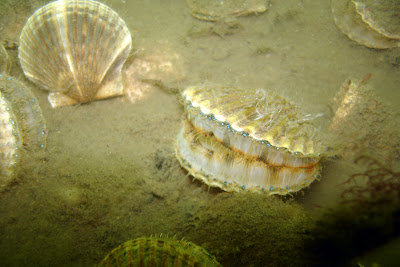
Adult bay scallop in a Codium fragile bed
Well, there were certainly a lot of bubbles yesterday. I went diving, but in addition to the normal exhalent bubbles from every breath, my Air2 was leaking, creating more bubbles and increasing my apparent air intake. But that didn't stop me from doing my transect surveys at 5 sites in the Peconics. We stopped all around Northwest Harbor (East Hampton, NY) and Sag Harbor, and then 1 dive in Southold Bay. While we didn't see as many scallops as we would have liked, we did see a few, which was good. In most places, we saw more seed

A seed bay scallop in Codium

A bay scallop "smiling" for the camera... Old Blue eyes


A seed bay scallop, note the darker mantle than the one above
than adults,

An adult bay scallop with its epiphytic and epizooic growth
which is good and bad. It is good in that hopefully there are enough seed to survive over the winter and spawn next year. It is bad for the commercial and recreational guys that there aren't enough adult scallops (potentially) to go around. Who knows how this year ends up. However, I did see a decent number of scallops,
small fish,

hermit crabs,


spider crabs,

mud crabs,

grass shrimp,


whelks,




your usual suspects. A nice day diving, although cold (12.5C). Its about time to break out my drysuit. The visibility and diving this time of the year is the best though, so I won't complain. Going again on Friday. Stay tuned.
























































